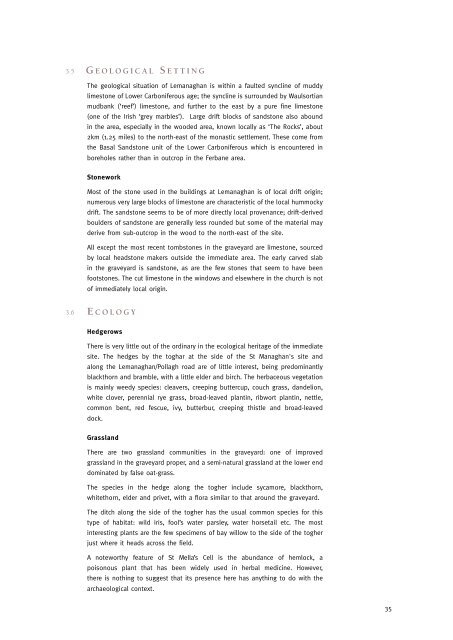Lemanaghan, County Offaly [PDF 1.96 - The Heritage Council
Lemanaghan, County Offaly [PDF 1.96 - The Heritage Council
Lemanaghan, County Offaly [PDF 1.96 - The Heritage Council
You also want an ePaper? Increase the reach of your titles
YUMPU automatically turns print PDFs into web optimized ePapers that Google loves.
3.5 G E O L O G I C A L S E T T I N G<br />
<strong>The</strong> geological situation of <strong>Lemanaghan</strong> is within a faulted syncline of muddy<br />
limestone of Lower Carboniferous age; the syncline is surrounded by Waulsortian<br />
mudbank (‘reef’) limestone, and further to the east by a pure fine limestone<br />
(one of the Irish ‘grey marbles’). Large drift blocks of sandstone also abound<br />
in the area, especially in the wooded area, known locally as ‘<strong>The</strong> Rocks’, about<br />
2km (1.25 miles) to the north-east of the monastic settlement. <strong>The</strong>se come from<br />
the Basal Sandstone unit of the Lower Carboniferous which is encountered in<br />
boreholes rather than in outcrop in the Ferbane area.<br />
Stonework<br />
Most of the stone used in the buildings at <strong>Lemanaghan</strong> is of local drift origin;<br />
numerous very large blocks of limestone are characteristic of the local hummocky<br />
drift. <strong>The</strong> sandstone seems to be of more directly local provenance; drift-derived<br />
boulders of sandstone are generally less rounded but some of the material may<br />
derive from sub-outcrop in the wood to the north-east of the site.<br />
All except the most recent tombstones in the graveyard are limestone, sourced<br />
by local headstone makers outside the immediate area. <strong>The</strong> early carved slab<br />
in the graveyard is sandstone, as are the few stones that seem to have been<br />
footstones. <strong>The</strong> cut limestone in the windows and elsewhere in the church is not<br />
of immediately local origin.<br />
3.6 E C O L O G Y<br />
Hedgerows<br />
<strong>The</strong>re is very little out of the ordinary in the ecological heritage of the immediate<br />
site. <strong>The</strong> hedges by the toghar at the side of the St Managhan's site and<br />
along the <strong>Lemanaghan</strong>/Pollagh road are of little interest, being predominantly<br />
blackthorn and bramble, with a little elder and birch. <strong>The</strong> herbaceous vegetation<br />
is mainly weedy species: cleavers, creeping buttercup, couch grass, dandelion,<br />
white clover, perennial rye grass, broad-leaved plantin, ribwort plantin, nettle,<br />
common bent, red fescue, ivy, butterbur, creeping thistle and broad-leaved<br />
dock.<br />
Grassland<br />
<strong>The</strong>re are two grassland communities in the graveyard: one of improved<br />
grassland in the graveyard proper, and a semi-natural grassland at the lower end<br />
dominated by false oat-grass.<br />
<strong>The</strong> species in the hedge along the togher include sycamore, blackthorn,<br />
whitethorn, elder and privet, with a flora similar to that around the graveyard.<br />
<strong>The</strong> ditch along the side of the togher has the usual common species for this<br />
type of habitat: wild iris, fool’s water parsley, water horsetail etc. <strong>The</strong> most<br />
interesting plants are the few specimens of bay willow to the side of the togher<br />
just where it heads across the field.<br />
A noteworthy feature of St Mella’s Cell is the abundance of hemlock, a<br />
poisonous plant that has been widely used in herbal medicine. However,<br />
there is nothing to suggest that its presence here has anything to do with the<br />
archaeological context.<br />
35

















